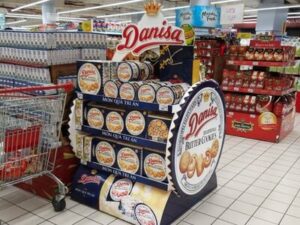The retail industry is highly competitive, and it’s not easy to convey to customers what you can offer to them. This gives rise to POSM (Point Of Sales Material), which is a collection of retail tools that contribute to brand recognition, often found in retail stores, supermarkets,..
Currently, POSM has become more diverse in terms of design and usage, but what factors help you maximize the effectiveness of POSM? In this article, A Dong will explore how to attract customers with POSM for a more effective usage strategy.
Overview and Considerations
Despite having many good products, whether a business can attract customers or not depends a lot on how they are marketed in the store. ‘74% of purchase decisions happen in-store and it depends on the customer’s perception of the product,’ according to The Alliance Center. That’s why a business’s POSM must be considered for its appeal, as consumers make purchasing decisions based on emotions, so businesses need to consider:
- Size: A larger screen is more eye-catching than a smaller one, but a smaller screen helps customers focus better at close range, depending on the context and the size of the POSM, thereby maximizing attention.
- Design: When you understand how consumers react to different colors, fonts, and other visual elements in purchasing behavior, you can create more effective designs, increasing brand awareness.
- Content: Good content alongside a cluttered image layout can ‘rescue’ the message your business wants to convey to customers, allowing your business to stand out through coherence.
- Materials: High-quality materials make a better impression on shoppers and are suitable for various layouts, but remember to balance that with cost-saving.
Creative design for attractive retail shelves
Relevant message
Beautiful imagery may capture the attention of shoppers, but the ability to convey a strong message will help transform them into buyers. A relevant message, aside from being easy to remember, can also communicate that this is the only product that can solve their problem, which is equally important.
A good POSM not only serves for advertising but also informs consumers why they should choose this product, which requires significant investment from businesses. Consumers need to quickly receive a clear message while still experiencing attraction and appeal. Depending on the event or time of the year, the content and design may vary but still maintain the essential brand message.
Furthermore, offline and online channels are no longer considered separate but are interdependent. According to Global Data Headlines, up to 53% of consumers will research products before making a purchase decision. Therefore, brands need to align what consumers see online with what is sold in physical stores
Although most shopping decisions are primarily made in-store, this is still an opportunity to nurture them into potential customers, from Google searches or social media to messages conveyed on POSM. Therefore, the brand’s message needs to be designed as a multi-channel experience
Shelves are designed for the upcoming Christmas season
Strategic location
A small principle when starting to display your products and accompanying POSM is to choose locations with high foot traffic in the store. Additionally, displaying complementary products close to each other is a proven way to increase cross-selling opportunities, making products more complete when they have additional items alongside them. For example: a coffee counter next to a milk counter, a bread counter next to a cheese counter, etc
Some POSM also maximize their effectiveness when placed in specific locations. At entrances and exits, you’ll often see Gondola shelving right at the front, on the shelves, you’ll find dividers or stickers, and in larger spaces, there might be islands for product display.
At checkout counters, you can find small, pocket-sized product display shelves, which often feature items typically forgotten during shopping. Free-standing or hanging LED screen systems are also quite common in stores, supermarkets, and malls. They are commonly positioned at entrances or near elevators, allowing customers to recall the brand one last time before leaving.
In addition, experiential and product testing counters also attract a lot of attention from customers entering and exiting the store. This can be an excellent strategy to promote and introduce new products, stimulate shopping desires, and encourage purchases without much consideration.
Gondola shelves
Technology
Incorporating technology into conventional POSM can often enhance effectiveness in unexpected ways. The most appropriate and accessible method is to use smartphones for in-store shopping consideration. A survey by Mobile Marketing through AdColony in 2019 showed that 61% of customers view their phones as shopping guides, from searching, reviewing, researching, comparing, to making purchasing decisions.
Currently, many brands and businesses have printed simple QR codes on their products to support the shopping consideration process. Other brands may also explore various ways to make their POSM more eye-catching, such as using lighting, digital touchscreens, voice interaction, running video advertisements, etc.
Hanging LED screens
Summary
In general, the key takeaway for businesses looking to optimize the effectiveness of their Point Of Sales Material (POSM) is to plan meticulously and choose POSM that is suitable for promoting each specific product.
When planning, consider what kind of experience you want customers to have when they observe or interact with your POSM. Adjust your message to align with your primary customer segments, and research the best locations that can maximize visibility for your products and brand. Lastly, apply technology that suits the needs and behaviors of consumers effectively.









